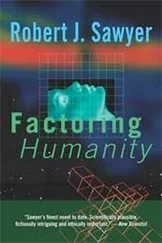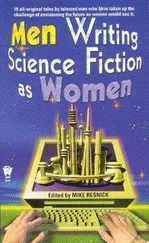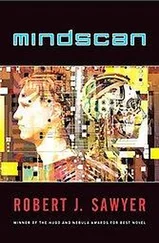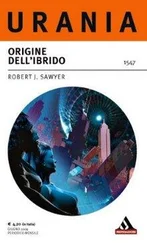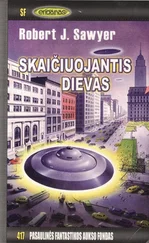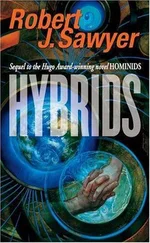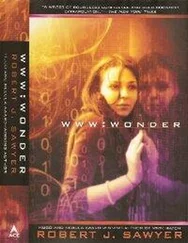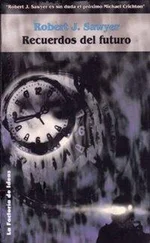Robert Sawyer - Calculating God
Здесь есть возможность читать онлайн «Robert Sawyer - Calculating God» весь текст электронной книги совершенно бесплатно (целиком полную версию без сокращений). В некоторых случаях можно слушать аудио, скачать через торрент в формате fb2 и присутствует краткое содержание. Город: New York, Год выпуска: 2000, Издательство: Tor Books, Жанр: Фантастика и фэнтези, на английском языке. Описание произведения, (предисловие) а так же отзывы посетителей доступны на портале библиотеки ЛибКат.
- Название:Calculating God
- Автор:
- Издательство:Tor Books
- Жанр:
- Год:2000
- Город:New York
- ISBN:нет данных
- Рейтинг книги:5 / 5. Голосов: 1
-
Избранное:Добавить в избранное
- Отзывы:
-
Ваша оценка:
- 100
- 1
- 2
- 3
- 4
- 5
Calculating God: краткое содержание, описание и аннотация
Предлагаем к чтению аннотацию, описание, краткое содержание или предисловие (зависит от того, что написал сам автор книги «Calculating God»). Если вы не нашли необходимую информацию о книге — напишите в комментариях, мы постараемся отыскать её.
Calculating God — читать онлайн бесплатно полную книгу (весь текст) целиком
Ниже представлен текст книги, разбитый по страницам. Система сохранения места последней прочитанной страницы, позволяет с удобством читать онлайн бесплатно книгу «Calculating God», без необходимости каждый раз заново искать на чём Вы остановились. Поставьте закладку, и сможете в любой момент перейти на страницу, на которой закончили чтение.
Интервал:
Закладка:
Along the sides of the doors were logos and names of the corporate sponsors who had made the exhibition possible, including Bank of Montreal, Abitibi-Price, Bell Canada, and the Toronto Sun.
Falsey and Ewell entered the gallery. A mural depicting a supposedly ancient ocean bottom dominated one wall, with all sorts of bizarre critters swimming around. Display cases with angled glass tops lined the other walls and a central room divider.
“Look,” said Ewell, pointing.
Falsey nodded. The cases jutted out from the walls; there was space underneath each one. Explosives could easily be planted there — but they’d probably be spotted, if not by adults, certainly by little kids.
There were perhaps a hundred people milling around, looking at the fossils or listening to video presentations about their discovery. Ewell pulled a small, spiral-bound notebook out of his hip pocket and began making notes. He walked through the gallery, counting the number of cases — there were twenty-six. Falsey, meanwhile, discreetly noted the three security cameras, two that were fixed, and one that panned back and forth. They would present a problem — but not an insurmountable one.
Ewell didn’t care what the fossils themselves looked like, but young Falsey did. He examined each case in turn. They contained slabs of gray shale held in place by little Plexiglas posts. It would be a tricky problem; although shales could shatter if dropped, they could also be quite strong. Unless the explosions were designed just right, the display cases might be damaged but the rocks with their bizarre fossils might escape unscathed.
“Mommy,” said a little boy, “what are those?” Falsey looked at where the child was pointing. At the back of the room were two large models: one showed a creature with numerous stiltlike legs and waving tentacles coming off its back. The other showed a creature walking on tubular legs with a forest of spikes rising up from its body.
The child’s mother, a pretty woman in her twenties, peered at a placard, then explained for her son. “Well, dear, see, they weren’t quite sure how this creature looked, because it’s so strange. Originally, they couldn’t even tell which way was up, so it’s been modeled two different ways here.”
The child seemed satisfied by the answer, but Falsey had to fight to keep from speaking. The fossil was an obvious lie, a test of faith. That it didn’t look right no matter which way you put it was proof that it had never really been alive. It tore his heart out to see a young mind being led astray by all this trickery.
Falsey and Ewell spent an hour in the gallery, completely familiarizing themselves with it. Falsey sketched the contents of each display case so that he knew exactly how the fossils were deployed within. Ewell noted the alarm systems — they were obvious if you knew what you were looking for.
And when they were done, they exited the museum. Outside, there was a large group of people, many sporting buttons depicting the traditional big-headed black-eyed gray alien; they’d been there when Falsey and Ewell had entered, too — UFO nuts and religious fanatics, waiting for a glimpse of the alien or its ship.
Falsey bought a tiny, oily bag of popcorn from a street vendor. He ate some and tossed the rest, kernel by kernel, at the numerous pigeons that were waddling along the sidewalk.
“Well,” said Ewell, “what do you think?”
Falsey shook his head. “No place to hide bombs. And no guarantee that even if we could hide them that the rock slabs would be damaged by the explosions.”
Ewell nodded reluctantly, as if he’d been forced to the same conclusion. “It means we’ll have to take direct action,” he said.
“I’m afraid so.” Falsey turned and faced the imposing stone facade of the museum, with its wide steps leading up to the glass entrance doors and the triptych of stained-glass windows rising up above those doors.
“Too bad we didn’t get to see the alien,” Falsey said.
Ewell nodded, sharing Cooter’s disappointment. “The aliens may believe in God, but they haven’t yet found Christ. Imagine if we could be the ones to introduce them to the Savior . . .”
“That would be glorious,” said Falsey, his eyes wide. “Absolutely glorious.”
Ewell pulled out the city map they’d been using. “Well,” he said, “it looks like if we take the subway four stops south, that will put us purty near the place where they tape The Red Green Show.” He tapped the large red square labeled “CBC Broadcasting Ctr.”
Falsey smiled, all thoughts of greater glory temporarily banned from his mind. They both loved The Red Green Show and had been surprised to learn it was made here in Canada. There was a taping tonight, and tickets were free. “Let’s go,” he said. They walked over to the entrance stairwell and descended below the street.
All right, I’ll admit it. There’s one good thing about dying: it causes you to be introspective. As Samuel Johnson said, “When a man knows he is to be hanged in a fortnight, it concentrates his mind wonderfully.”
I knew why I was resisting the notion of intelligent design so much — why almost all evolutionists do. We had fought for more than a century against creationists, against fools who believed that the Earth was made in 4004 B.C. during six literal twenty-four-hour days; that fossils, if they had any validity at all, were remnants of Noah’s flood; that a deceptive God had created the universe with starlight already en route to us, giving the illusion of great distances and great age.
The popular account was that Thomas Henry Huxley had slain Bishop “Soapy Sam” Wilberforce in the great evolution debate. And Clarence Darrow, so I’d been taught, had buried William Jennings Bryan during the Scopes trial. But the battle had only begun with them. Others kept coming, spewing garbage under the guise of so-called creation science, forcing evolution out of the classroom, even today, even here at the beginning of the twenty-first century, trying to force a literal, fundamentalist interpretation of the Bible into the mainstream.
We’d fought the good fight, Stephen Jay Gould, Richard Dawkins, and even me, to a lesser extent — I didn’t have the soapbox of the other two, but I’d debated my share of creationists at the Royal Ontario Museum and U of T. And twenty years ago, the ROM’s own Chris McGowan had written a crackerjack book called In the Beginning: A Scientist Shows Why the Creationists Are Wrong. But I remember a friend of mine — a guy who teaches philosophy — pointing out the arrogance of that subtitle: one man was going to show why all the creationists everywhere were benighted. Maybe we could be forgiven our siege mentality, though. Polls in the United States showed that even today, less than a quarter of the population believed in evolution.
To grant that there had been any guiding intelligence, at any point, would open the floodgates. We’d struggled so long, and so hard, and some of us had even been jailed for the sake of the cause, that to allow for even a moment the possibility of an intelligent designer would be tantamount to raising the white flag. The media, we’d felt sure, would have a field day, ignorance would reign supreme, and not only would Johnny be unable to read, he wouldn’t know any real science, either.
In retrospect, maybe we should have been more open, maybe we should have considered other possibilities, maybe we should not have glossed so readily over the rough spots in Darwin’s theory, but the cost, it had always seemed, was too high.
The Forhilnors weren’t creationists, of course — no more so, really, than were any scientists who accepted the big bang, with its definite creation point (something Einstein had found so abhorrent to common sense that he’d made what he regarded as the “greatest blunder” of his life, cooking his equations for relativity to avoid the universe ever having a beginning).
Читать дальшеИнтервал:
Закладка:
Похожие книги на «Calculating God»
Представляем Вашему вниманию похожие книги на «Calculating God» списком для выбора. Мы отобрали схожую по названию и смыслу литературу в надежде предоставить читателям больше вариантов отыскать новые, интересные, ещё непрочитанные произведения.
Обсуждение, отзывы о книге «Calculating God» и просто собственные мнения читателей. Оставьте ваши комментарии, напишите, что Вы думаете о произведении, его смысле или главных героях. Укажите что конкретно понравилось, а что нет, и почему Вы так считаете.

